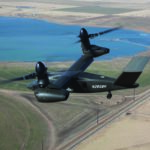Is This Really the B-21? On July 6, the U.S. Air Force Rapid Capabilities Office (RCO) released the third artist rendering since 2015 of the B-21 Raider stealth bomber, and the latest depiction sparked a round of trade journalism articles about how the latest depiction differed from the previous two–articles that lacked any commentary from Air Force officials or outside experts. The articles noted that the new rendering’s windscreen configuration shows one, “new” narrow, slanted window on the left side of the cockpit. The new depiction also shows a bulkier B-21 midsection, presumably for the higher weapons carriage for the next-generation bomber. The B-21 looks to have a simpler “W” tail than the more jagged, 4 V-shaped tail of the B-2–presumably because the Air Force has achieved significant advances in low-observables technology in the last two decades. “Unfortunately, this is also an artist’s rendering, so it might not be a completely accurate depiction of the final aircraft,” said Richard Aboulafia, the vice president of analysis at the Teal Group. “But it certainly does look more aggressive with a more prominent, pointed front. Who knows if that’s the real appearance?”
…First Flight. James McAleese, the head of McAleese & Associates, said that the release of the rendering comes at a pivotal point for the B-21, as the Air Force looks to gain support in Congress for the bomber ahead of a “mid-2022” first flight and possibly for low-rate initial production in 2023. “Presumably, RCO is showcasing both B-21 schedule, plus emerging B-21 lethality in the highly-lethal China fight, in anticipation of both 2022 congressional mark-ups, plus separate 2023-2027 POM,” per McAleese.
Minuteman III Debrief. Boeing said it expects to receive a debriefing from the U.S. Air Force in the next several weeks on the company’s loss to Northrop Grumman on July 7 for a contract worth up to nearly $3.9 billion through 2039 for Minuteman III ICBM ground subsystem support. Northrop Grumman was the incumbent for the Minuteman III ground subsystem work, as the company had beaten Boeing for a $963 million five-year contract for such support in January 2015. While Boeing built the Minuteman III and continues to develop ground subsystems for the ICBM, Northrop Grumman is assuming a larger role in the ICBM field. Northrop Grumman is also the contractor on the next generation Ground Based Strategic Deterrent, which is to replace the Minuteman III.
Missile Defense. Lockheed Martin and Israel Aerospace Industries (IAI) entered a memorandum of Understanding (MOU) to collaborate on integrated air and missile defense (IAMD) systems, IAI said July 6. The companies are set to look into potential joint opportunities in research and development, production, marketing and other activities. They will both set up an executive steering committee and working groups to implement the cooperation. “This new Memorandum of Understanding is yet another step in our strategy for cooperation with IAI, as a partner in some of our key programs,” Lockheed Martin Senior Vice President, Global Business Development Tim Cahill said in a statement. He noted this opens new opportunities for the company. IAI president and CEO Boaz Levy said this MOU “is a strategic agreement for us. Combining the development capabilities and the vast know-how of Lockheed Martin and IAI experience accumulated over the years in IAMD systems will create win-win opportunities for both sides.”
Aircraft To Afghanistan. The U.S. plans to provide 37 additional Black Hawk helicopters to the Afghan Air Force to bolster their capabilities in the face of the Taliban’s increasing activity to claim larger portions of the country’s territories, Pentagon Spokesman John Kirby told reporters on July 8. Two refurbished UH-60s were delivered this month with 35 more to come, he said. Kirby added the U.S. is also planning to provide the Afghan air force with three additional Super Tucano A-29 strike aircraft and will help “manage an overhaul process for some of their Mi-17 helicopters…We’re committed in very tangible ways to improving their air force capabilities. And we’re also going to be working to provide logistical or maintenance support for their forces going forward.”
SecNav. The Senate Armed Services Committee has scheduled a nomination hearing for July 13 with Carlos Del Toro, nominee to be the next Secretary of the Navy. The White House announced his nomination on June 11. Del Toro served in the Navy for 22 years, eventually being Senior Executive Assistant to the Director for Program Analysis and Evaluation in the Office of the Secretary of Defense, and Special Assistant to the Director and Deputy Director of the Office of Management and Budget. For the last 17 years he has served as the CEO and president of SBG Technology Solutions, which he founded in 2004. If confirmed, Del Toro would relieve Thomas Harker, who has served in an acting role since President Biden took office in January. Committee Chairman Sen. Jack Reed (D-R.I.) initially welcomed the nomination, calling him an “excellent selection.”
New Bell Facility. Bell announced plans on July 6 to build a new Systems Integration Lab (SIL) at its Flight Research Center in Arlington, Texas that will support testing for its work on the Army’s Future Long-Range Assault Aircraft (FLRAA) and Future Attack Reconnaissance Aircraft (FARA) programs. Construction is expected to begin within the coming weeks, the company said. “This new facility is being built to perform risk reduction, integration, verification and validation testing on air vehicle and mission systems and the software needed to meet requirements for Future Vertical Lift complete weapon system development programs,” the company wrote. “The SILs are designed to quickly integrate and test mission and air vehicle system capabilities while also demonstrating sustainment capabilities to meet program requirements, enabling open and direct collaboration between government and industry partners.” Bell is currently offering its V-280 Valor tiltrotor aircraft for FLRAA and the 360 Invictus helicopter for FARA.
P-8A. The first of five Boeing P-8A Poseidon maritime patrol aircraft headed to Norway left the paint shop in Renton, in the Royal Norwegian Air Force livery, the company said July 9. Norway named its five aircraft after Norse mythological figures in Vingtor, Viking, Ulabrand, Hugin and Munin. The P-8s are set to replace the current fleet of P-3 Orions. The first aircraft, Vingtor, will next return to the factory floor to prepare for flight testing, with the first flight planned for later this month. Mission systems will be installed on the P-8A after the first flight.
New CEO. Former U.S. Air Force acquisition chief Will Roper is the new CEO of Volansi, a Concord, Calif.-based drone maker. Roper had joined Volansi’s board in March after stepping down as Air Force acquisition chief on Jan. 20 before President Joe Biden took office. Included in the Volansi portfolio are unmanned aerial vehicles, such as the Voly C20 and Voly M20 class 3 UAVs. The Voly C20 is able to port 20 pounds of cargo or conduct intelligence, surveillance, and reconnaissance missions, while the Voly M20 is able to carry 20 pounds of payload and 10 pounds of sensors. Overall, Volansi plans a spectrum of drones from 10 to 200 pounds and a range of 50 to 500 miles. Volansi serves commercial and government operators in tactical aerial resupply, medical deliveries, and disaster relief.
…Ethics Guidelines. While Roper was Air Force was acquisition chief, the Air Force chose Volansi as one of the companies to participate in the Skyborg Vanguard program for a low-cost attritable demonstrator, but Roper has said he will abide by federal ethics guidelines and that his main focus is pursuing innovation in linking the dotcom and dotmil worlds. If an Air Force contract under Roper’s purview was pending in the last year before he left office, he is barred for two years from communicating with the federal government or appearing before the federal government in connection with that contract, and there is a one-year ban on him meeting with the Air Force on behalf of Volansi. Volansi founder and former CEO Hannan Parvizian is moving to chief technology officer and product architect. Volansi said that Roper’s “extensive experience in logistics will help Volansi scale its operations and partnerships in defense as well as commercial applications.”
DDG-75. The Arleigh Burke-class destroyer USS Donald Cook (DDG-75) left Naval Station Rota, Spain for the last time as a Forward Deployed Naval Forces-Europe (FDNF-E) ship on June 30. DDG-75 is being replaced by the USS Arleigh Burke (DDG-51) as the second of four scheduled homeport shifts occurring with the Rota-based ships. Previously, the Roosevelt (DDG-80) replaced USS Carney (DDG-64) at Rota. DDG-75 first joined the 6th Fleet in 2014 as one of the first FDNF-E destroyers under Commander, Task Force 65. In 2019, the Navy said it planned to cycle out the four Rota-based destroyers with different ships and add a helicopter squadron. The FDNF-E destroyers were initially deployed as part of the Obama administration’s 2011 European Phased Adaptive Approach to missile defense in Europe, before Aegis Ashore facilities were constructed.
SM-2 IIIC. The Navy awarded Raytheon Technologies a $45 million modification to exercise an option for fiscal year 2021 Standard Missile (SM)-2 Block IIIC low-rate initial production and spares. Work will largely be split between Tucson, Ariz. (40 percent); Salt Lake City, Utah (10 percent); Wolverhampton, England (9 percent); and Andover, Mass. (6 percent) and is expected to be finished by September 2024. The full amount was obligated at the time of award and will not expire at the end of this fiscal year. This modification adds to an original $149 million December 2018 contract for the engineering, manufacturing and development of the SM-2 Block IIIC missile.
T-EPF 5. The Military Sealift Command Spearhead-class Expeditionary Fast Transport ship USNS Trenton (T-EPF 5) conducted joint maritime domain awareness operations with the Tunisian navy fast patrol boats Hamilcar (505) and Giscon (510) and Tunisia’s Auxiliary Ships Zaris (A710) and Taguermess from June 28 to July 2, the U.S. Navy said. Cmdr. T. J. Seifert, officer in charge of the military detachment aboard Trenton said the exercise provided “valuable interoperability training” to both countries for at-sea maritime interdiction operations and maritime domain awareness. This will help Tunisia protect its maritime border, Seifert added. This set of exercises came after the USNS Trenton previously worked with the Tunisian navy in January as well. More recently, in May the Expeditionary Sea Base USS Hershel “Woody” Williams (ESB-4) conducted joint maritime operations with the Tunisian navy during the Phoenix Express exercise.
Coast Guard Helo Order. The Coast Guard has ordered five new MH-60T helicopter hulls from Lockheed Martin’s Sikorsky Aircraft unit, brining the total number of new hulls ordered to 30 as part of the service’s service life extension program (SLEP) of its original fleet of 45 MH-60Ts. The latest order, valued at just over $34 million, brings the total order value to about $241 million going back to January when the initial order was placed for 25 hulls. Delivery of the first new hull is expected in early 2023 with subsequent deliveries of about one per month beginning in late 2023. The new hulls provide 20,000 hours of service life. Other elements of the SLEP include replacing main rotor blades and electrical wire harnesses. Work will be done at the service’s Aviation Logistics Center in North Carolina.













